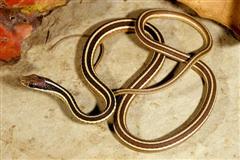Ribbon Snake - Eastern
Scientific Name: Thamnophis sauritus sauritus
Thu, 17th April, 2025 - 8:03 am GMT
Sponsor Ads:

Alternative Name
Scientific Name: Thamnophis sauritus sauritusBasic Info
The tail of the Eastern Ribbon Snake usually composes more than a third of its total body length. These beautifully striped snakes often grow to lengths between 18 and 26 inches, and are often mistaken for Garter Snakes, though Garter Snakes have shorter tails. Eastern Ribbon Snakes have a reddish brown color that is accented by three distinct yellow stripes. The middle stripe sometimes has a green to orange tint. Each stripe on the side of the snake's body is outlined on the edge closest to the belly by a darker line. This adds definition to the belly, which is usually a light shade of yellow or green. When the skin is stretched out, a double row of darker spots may appear between the stripes. There may be white or yellow bars near the eyes of the Eastern Ribbon Snake, and often the labial scales are yellow to white. All the scales of the Eastern Ribbon Snake are keeled.
Health
Usually, aspen shavings or newspaper makes good substrates, although because of the aquatic nature of the Eastern Ribbon Snake, newspaper may need to be replaced frequently. A bowl of water large enough for the snake to entirely submerge itself in is adequate, although a container large enough to swim in would be more desirable. Generally, however, the land area should have fairly low humidity levels. During the day, temperatures between 80 and 85 degrees Fahrenheit are appropriate for the warm end of the enclosure, with the cool end about 70 degrees Fahrenheit . At night the temperature should be about 65 degrees. Feeder fish and insects may be the preferred diet for Eastern Ribbon Snakes, and pinkie mice may be a good dietary item if they are accepted. Breeding Eastern Ribbon Snakes usually breed between April and May after a period of brumation. Males are usually shorter than females. Females may also have thicker bodies than males. Between ten and 12 live young will be born some time between July and August. If the eggs have been left in the terrarium, the hatchlings should be removed from the terrarium as soon as possible or the parents may eat them.Habitat
They are usually found in wet habitats near the edges of ponds, streams, or other bodies of water.Behavior
The Ribbon Snake is a sleek snake that would make a beautiful pet for a beginning snake owner. Usually, the easily tamed Eastern Ribbon Snake will not bite; rather, they release a smelly musk when frightened or alarmed. Often, captive Eastern Ribbon Snakes may remain rather easily stressed or nervous. Many may calm down if regularly handled. It has been reported that they will give off a musk smell if they are overly nervous. In the wild, frightened Eastern Ribbon Snakes usually seek shelter in the water or in thick vegetation. Eastern Ribbon Snakes are adept swimmers, though they usually remain in shallow waters toward the surface. Eastern Ribbon Snakes often become dormant in periods of dry weather, although they are quite active in the spring. They seem to enjoy basking on partially submerged objects in the water near their homes. They are quite fast and agile and may escape easily in captivity, though they are rather easy to care for and can make a good snake for a beginner.Origin
North and South AmericaHistory
The Eastern Ribbon Snake is found throughout Central and North America. In some parts of its range it may be confused with the Northern Ribbon Snake and the Garter Snake.Common Foods
They feed mainly on amphibians like frogs, although these snakes may also eat insects (such as Red Worms) and fish.Sponsor Ads:
Nothing in the universe arouses more false hopes than the first four hours of a diet. -- Unknown
Ribbon Snake - Eastern
Coded by: BGID® | ALL RIGHTS RESERVED Copyright © 2000-2025
Disclaimer | Privacy | Report Errors / Contact | Credits








 President of the United States of America - Real Estate mogul, Pageant owner and now one of the most controversial men in political history.
President of the United States of America - Real Estate mogul, Pageant owner and now one of the most controversial men in political history.  Politician, US Vice President and President of the USA - Joseph Robinette Biden Jr.
Politician, US Vice President and President of the USA - Joseph Robinette Biden Jr.  versus
versus  Russia: 'The Evil Empire'? Are they all that bad or is it just the USA trying to portray Russia as bad because they are a world power with land bigger and a society very different from the USA ideal?
Russia: 'The Evil Empire'? Are they all that bad or is it just the USA trying to portray Russia as bad because they are a world power with land bigger and a society very different from the USA ideal?  Global warming has been in and out as the "latest" hot topic for many years. It is, according to modern scientists, the result of man-made industrial pollutants, clearing forested areas, agriculture, etc. But now they are thinking it started way before the Industrial Revolution...
Global warming has been in and out as the "latest" hot topic for many years. It is, according to modern scientists, the result of man-made industrial pollutants, clearing forested areas, agriculture, etc. But now they are thinking it started way before the Industrial Revolution... 
 Corona virus
Corona virus 
 Users with wide screen monitors can benefit from more content on every page.
Users with wide screen monitors can benefit from more content on every page.